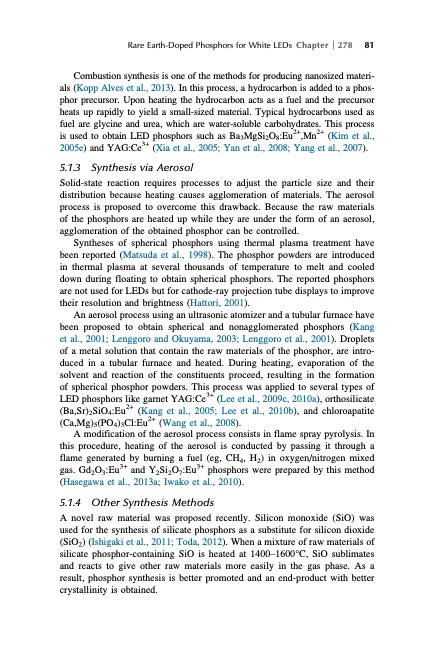
PDF Publication Title:
Text from PDF Page: 117
Rare Earth-Doped Phosphors for White LEDs Chapter 278 81 Combustion synthesis is one of the methods for producing nanosized materi- als (Kopp Alves et al., 2013). In this process, a hydrocarbon is added to a phos- phor precursor. Upon heating the hydrocarbon acts as a fuel and the precursor heats up rapidly to yield a small-sized material. Typical hydrocarbons used as fuel are glycine and urea, which are water-soluble carbohydrates. This process is used to obtain LED phosphors such as Ba3MgSi2O8:Eu2+,Mn2+ (Kim et al., 2005e) and YAG:Ce3+ (Xia et al., 2005; Yan et al., 2008; Yang et al., 2007). 5.1.3 Synthesis via Aerosol Solid-state reaction requires processes to adjust the particle size and their distribution because heating causes agglomeration of materials. The aerosol process is proposed to overcome this drawback. Because the raw materials of the phosphors are heated up while they are under the form of an aerosol, agglomeration of the obtained phosphor can be controlled. Syntheses of spherical phosphors using thermal plasma treatment have been reported (Matsuda et al., 1998). The phosphor powders are introduced in thermal plasma at several thousands of temperature to melt and cooled down during floating to obtain spherical phosphors. The reported phosphors are not used for LEDs but for cathode-ray projection tube displays to improve their resolution and brightness (Hattori, 2001). An aerosol process using an ultrasonic atomizer and a tubular furnace have been proposed to obtain spherical and nonagglomerated phosphors (Kang et al., 2001; Lenggoro and Okuyama, 2003; Lenggoro et al., 2001). Droplets of a metal solution that contain the raw materials of the phosphor, are intro- duced in a tubular furnace and heated. During heating, evaporation of the solvent and reaction of the constituents proceed, resulting in the formation of spherical phosphor powders. This process was applied to several types of LED phosphors like garnet YAG:Ce3+ (Lee et al., 2009c, 2010a), orthosilicate (Ba,Sr)2SiO4:Eu2+ (Kang et al., 2005; Lee et al., 2010b), and chloroapatite (Ca,Mg)5(PO4)3Cl:Eu2+ (Wang et al., 2008). A modification of the aerosol process consists in flame spray pyrolysis. In this procedure, heating of the aerosol is conducted by passing it through a flame generated by burning a fuel (eg, CH4, H2) in oxygen/nitrogen mixed gas. Gd2O3:Eu3+ and Y2Si2O7:Eu3+ phosphors were prepared by this method (Hasegawa et al., 2013a; Iwako et al., 2010). 5.1.4 Other Synthesis Methods A novel raw material was proposed recently. Silicon monoxide (SiO) was used for the synthesis of silicate phosphors as a substitute for silicon dioxide (SiO2) (Ishigaki et al., 2011; Toda, 2012). When a mixture of raw materials of silicate phosphor-containing SiO is heated at 1400–1600°C, SiO sublimates and reacts to give other raw materials more easily in the gas phase. As a result, phosphor synthesis is better promoted and an end-product with better crystallinity is obtained.PDF Image | HANDBOOK ON THE PHYSICS AND CHEMISTRY OF RARE EARTHS

PDF Search Title:
HANDBOOK ON THE PHYSICS AND CHEMISTRY OF RARE EARTHSOriginal File Name Searched:
Chemistry-Rare-Earths-49.pdfDIY PDF Search: Google It | Yahoo | Bing
Sulfur Deposition on Carbon Nanofibers using Supercritical CO2 Sulfur Deposition on Carbon Nanofibers using Supercritical CO2. Gamma sulfur also known as mother of pearl sulfur and nacreous sulfur... More Info
CO2 Organic Rankine Cycle Experimenter Platform The supercritical CO2 phase change system is both a heat pump and organic rankine cycle which can be used for those purposes and as a supercritical extractor for advanced subcritical and supercritical extraction technology. Uses include producing nanoparticles, precious metal CO2 extraction, lithium battery recycling, and other applications... More Info
| CONTACT TEL: 608-238-6001 Email: greg@infinityturbine.com | RSS | AMP |